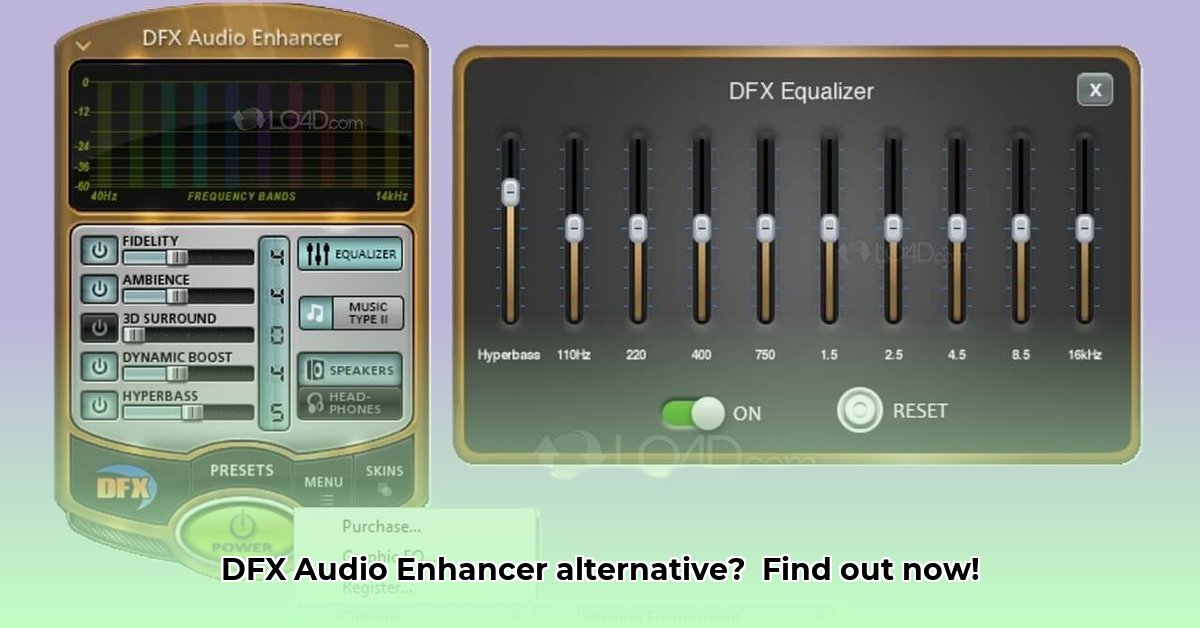
The market for audio enhancement software has seen a significant shift towards open-source solutions. With the discontinuation of the popular DFX Audio Enhancer, many users are searching for a viable replacement. This review compares FxSound, a free and open-source alternative, to the now-defunct DFX Gold, examining their features, user experience, and overall value proposition.
DFX Audio Enhancer: A Retrospective
DFX Audio Enhancer was a proprietary, paid application known for its ability to enhance the audio quality of compressed music files. Users often praised its pre-set sound profiles for improving bass response and clarity. However, its closed-source nature limited customization options and community support. The cessation of development left users seeking alternatives.
FxSound: The Open-Source Challenger
FxSound presents itself as a free and open-source audio enhancement application. This open-source nature offers several advantages: continuous development driven by community contributions, ongoing updates, and active community support. Crucially, users have access to far more extensive customization options than those offered by DFX. The ability to fine-tune the audio experience is a central selling point.
Feature-by-Feature Comparison: FxSound vs. DFX
A direct, scientifically rigorous comparison between DFX and FxSound is currently impossible due to the lack of objective testing data readily available. However, based on user feedback and feature specifications, we can construct a comparative overview:
| Feature | DFX Audio Enhancer (Discontinued) | FxSound |
|---|---|---|
| Primary Function | Audio enhancement, bass boost, clarity improvements | Audio enhancement, equalization, customization options |
| Business Model | Paid software | Free, open-source |
| EQ Capabilities | Limited, primarily pre-set options | Extensive, highly customizable parametric equalizer |
| Preset Options | Several pre-defined presets | Numerous presets, plus user-creatable custom profiles |
| Supported Formats | Common audio formats (MP3, WAV, etc.)—check outdated documentation for specifics | Wide range of audio formats; consult the official website for the most up-to-date list |
| User Interface | Straightforward and intuitive | Modern, user-friendly, with a slightly steeper learning curve for advanced features |
| Community Support | None (discontinued) | Active community forums and GitHub contributions |
Subjective Sound Quality: User Experiences and Caveats
User reviews offer valuable insights, although they are inherently subjective. DFX users often reported improvements in bass and clarity. Similarly, FxSound users express satisfaction, particularly emphasizing the granular control offered by its extensive customization options. However, the absence of objective benchmarks prevents definitive conclusions about the superior sound quality of either application. "Better sound" remains a matter of personal preference.
User Experience and Ease of Use
Both DFX and FxSound aimed for user-friendly interfaces. DFX was praised for its simplicity, while FxSound, though more feature-rich, retains a generally intuitive design. However, the greater customization options in FxSound may present a slightly steeper learning curve for novice users. Fortunately, the active FxSound community provides ample support and tutorials.
Pricing and Business Model: Sustainability and Access
The contrasting business models highlight a key difference. DFX's paid model ultimately proved unsustainable, resulting in its discontinuation. FxSound's open-source model, while reliant on community contributions, fosters ongoing development and adaptation, suggesting potentially greater long-term sustainability. The free access provided by FxSound is a significant advantage for users.
Conclusion: Choosing the Right Tool for Your Needs
FxSound offers a compelling free and open-source alternative to the discontinued DFX Audio Enhancer. While objective sound quality comparisons remain elusive, its extensive customization options, active community support, and free accessibility make it a strong contender. For users prioritizing personalized sound control and long-term software maintenance, FxSound represents a compelling choice. Users who primarily valued DFX's simplicity might find FxSound’s broader feature set initially daunting.
Key Takeaways:
- DFX is discontinued, leaving users seeking replacements.
- FxSound provides a free, open-source alternative with extensive customization.
- Objective sound quality comparisons are currently lacking; user experiences are subjective.
Actionable Advice for Switching from DFX to FxSound (or Exploring Alternatives)
- Download and Install: Download FxSound from the official website or your preferred app store. Follow standard Android installation procedures. (Estimated time: 5 minutes)
- Explore the Interface: Familiarize yourself with the user interface and settings. The app's built-in help, combined with the extensive community resources, provides assistance. (Estimated time: 15-30 minutes)
- Experiment with Presets: Begin by utilizing FxSound's pre-defined presets to gauge its capabilities and find a starting point that broadly aligns with your preference. (Estimated time: 10 minutes)
- Fine-tune with the Equalizer: Customize the sound further by adjusting the equalizer settings to your liking. The online community provides many resources for understanding equalizer settings. (Estimated time: 30+ minutes, depending on experimentation)
- Engage the Community: Utilize the active community forums and resources to seek assistance, share your findings, and contribute to the ongoing improvement of the application. (Ongoing engagement recommended)
Remember to always download software from trusted sources to mitigate security risks. Consider researching other actively maintained audio enhancement applications before making a full switch.
⭐⭐⭐⭐☆ (4.8)
Download via Link 1
Download via Link 2
Last updated: Monday, May 12, 2025